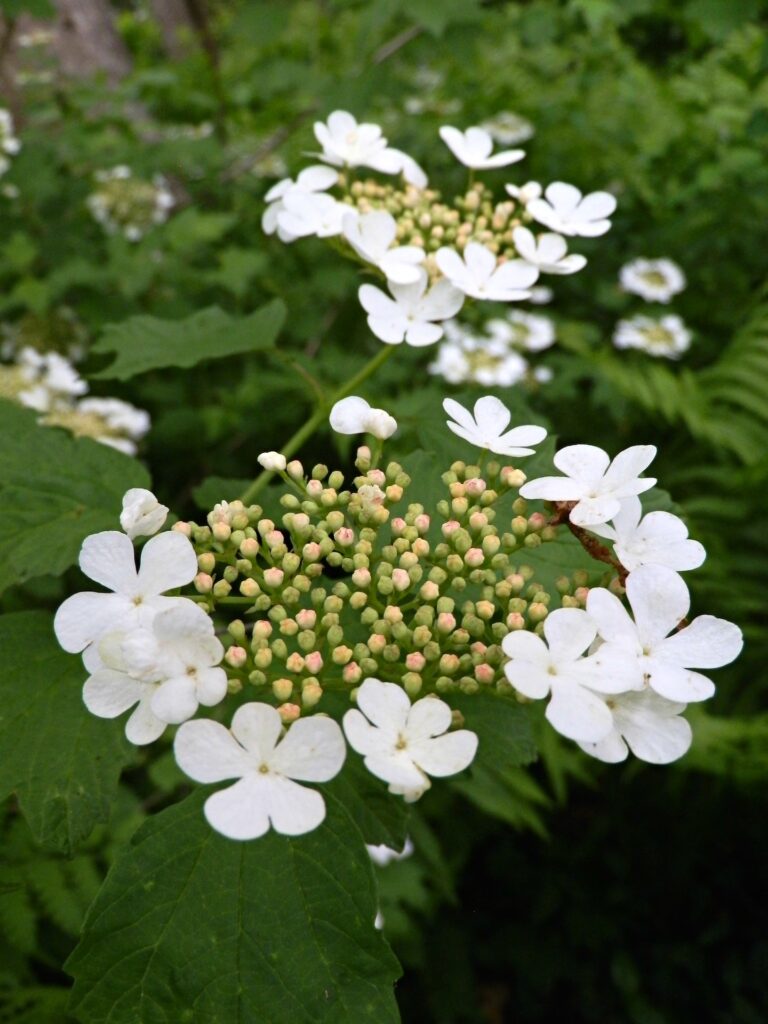Plant Profile: Highbush Cranberry
Highbush cranberry is a good choice for the edges of either a woodland or a sunny garden. It seems to find its sweet spot where an open area meets tall trees.
Known by many common names, including American cranberry bush, crampbark tree, dog rowan tree, rose elder, wild gueldes-rose, gaiter tree, love rose and many others, this hardy shrub is taxonomically known as both V. trilobum and V. opulus L. var. americanum. The latter draws from the fact that the native plant is extremely similar to the Eurasian V. opulus. Nonnative cranberry bush and cultivars often hybridize with the North American native. Both are edible and grow in similar conditions, but the native shrub’s berries are described as more palatable to humans. Both species have tart fruits that can be used in jams and jellies.
This shrub supports wildlife year-round. The blooms of spring, which are clusters of tiny florets surrounded by larger florets, attract butterflies, bees and other pollinators. During the growing season, highbush cranberry is a larval host plant for the spring azure butterfly. In the fall and winter, animals, including birds, snack on the shrub’s bright red berries, which resemble its namesake cranberries, although the two plants are not closely related. Cedar waxwings, in particular, are reportedly big fans of these berries. Fortunately, rabbits and deer seem to mostly leave the plant alone.
In addition to its year-round wildlife value, this Viburnum also offers year-round garden interest—from the white to pinkish lacy buds and flowers of spring, through the golden-olive green to purplish-to-red-tinged foliage of autumn, to the bright red berries of winter. Although the shrubs flower profusely in spring, they’ll produce even more berries if multiple plants are available in the garden; each flower is “perfect”—with both male and female parts—but self-infertile, so it requires cross-pollination with another flower.
Planting highbush cranberry along the edges of the garden provides wildlife value, screening, and pleasant transitions between garden rooms. Shrubs grow relatively fast—up to 3 feet per year. Annual pruning will maintain the desired height and width.
Viburnum trilobum tolerates a wide range of soils, but prefers the consistent moisture of its native habitat: moist woods and lake margins. While it grows in full sun to shade, it thrives in partial shade. When planted in full sun, highbush cranberry may need regular watering until established to satisfy its moisture needs.
Highbush cranberry can be propagated both from seed and cuttings. The shrub often reseeds in the garden, although small seedlings are easily pulled or transplanted. Shrubs can be started from nursery stock or other gardeners’ cuttings. It’s not a fussy young plant, except for its water needs.
If you’d like to add a native, moderately sized shrub with year-round garden interest, consider the highbush cranberry. The neighborhood birds will thank you in winter when other berries and food sources are gone.
This article by Beth Stetenfield first appeared in the November/December 2020 edition of the Northern Gardener. She is a garden blogger and writer, and a master naturalist volunteer and instructor.
For more information and inspiration for your northern garden, join the hort!



Hi Beth, I enjoyed your article as I added two Red Wing Highbush American Cranberry shrubs to my garden this summer. They were both btw 4-5’. I’m wondering how long it will take for mine to become “established”. Based on a growth rate of 3’ per year I think mine are about 2 years old. At this time, both shrubs have bottom branches right at ground level. Are they too young to prune at this point? Thanks, Robbie
Yes, you can prune them.
How closely can I plant native cranberries? I’m looking to build a screen hedge on a southern property border to screen out a road. Also, are they salt tolerant as they would be twenty to twenty-five feet off the road?
They can get up to 10 feet wide, so give them plenty of room in a hedge. They are not listed as salt tolerant. Here’s more info from the U of Illinois. https://web.extension.illinois.edu/shrubselector/detail_plant.cfm?PlantID=468
Hello,
I just had a friend give me some cuttings of her high bush cranberry and I have a walnut tree. Would it be harmful if I planted the cranberry bush near my walnut tree? It probably would be about 20 feet away.
Thanks in advance!
This is fine. I have several growing within 20 ft of a very large black walnut